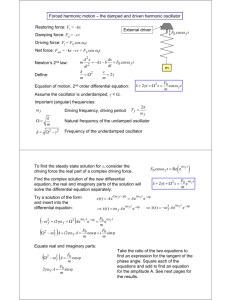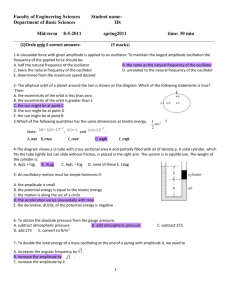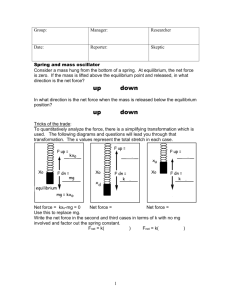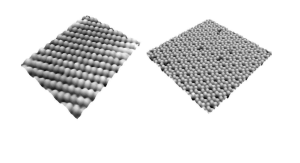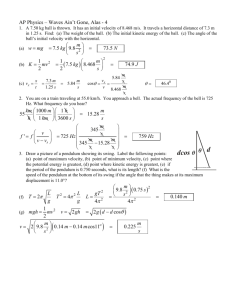Wed 9/30
advertisement
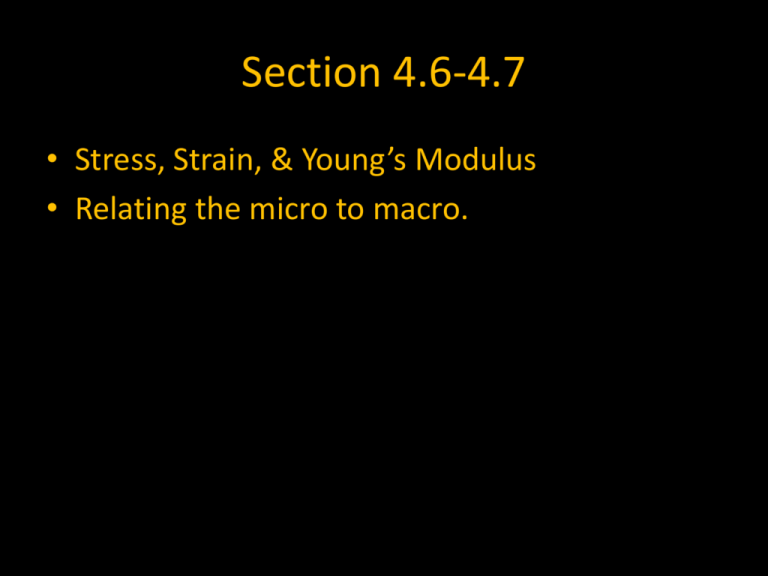
Section 4.6-4.7 • Stress, Strain, & Young’s Modulus • Relating the micro to macro. Wires as Masses on Identical Parallel and Series Springs The Micro-Macro Connection: Stiffness for springs in series and in Parallel Length=Nser*dbond Area=Npar*d2bond F ktot L N par A 2 d N ser L d A F k1 L Q4.6.d: Wires d L You hang a 10 kg mass from a What happens? copper wire, and the wire a) The second wire stretches stretches by 8 mm. 4 mm Now you hang the same mass b) The second wire stretches from a second copper wire, 8 mm whose cross-sectional area is c) The second wire stretches half as large (but whose 16 mm length is the same). Q4.6.e: Wires A F k1 L d L You hang a 10 kg mass from a copper wire, and the wire stretches by 8 mm. Now you hang the same mass from a second copper wire, which is twice as long, but has the same diameter. What happens? a) The second wire stretches 4 mm b) The second wire stretches 8 mm c) The second wire stretches 16 mm Young’s Modulus Two wires with equal lengths are made of pure copper. The diameter of wire A is twice the diameter of wire B. You make careful measurements and compute Young's modulus for both wires. What do you find? When 6 kg masses are hung on the wires, wire B stretches more than wire A. Y = (F/A)/(DL/L) = k/d 1) YA > YB 2) YA = YB 3) YA < YB Example: You hang a heavy ball with a mass of 14 kg from a silver rod 2.6m long by 1.5 mm by 3.1mm. You measure a stretch of the rod, and find that the rod stretched 0.002898 m. Using these experimental data, what value of Young’s modulus do you get? The density of silver is 10.5 g/cm3 and you can look up its atomic mass. What’s the inter-atomic spring stiffness? Normal Force Speed of Sound in a Solid: the logic n n-1 n+1 d n-1 d n n+1 x xn-1 xn xn+1 stretchleft stretchright ((xn – xn-1 ) – d) ((xn+1 - xn ) – d) Fn , Left k s (( xn xn 1 ) d )) Fn , Right k s (( xn 1 xn ) d )) Fn ,net Fn , Left Fn , Right k s (( xn xn 1 ) d )) k s (( xn 1 xn ) d )) Fn ,net k s ( xn 1 xn 1 2 xn ) Copmutational simulation Speed of Sound in a Solid n n-1 m n-1 xn-1 k d m n xn n+1 d k m n+1 x xn+1 Fn ,net k s ( xn 1 xn 1 2 xn xn 1 ) Informed Guess at v’s dependence Stiffer, for a given atomic displacement, greater force pulling it so greater velocity achieved. ks v d m More distance between atoms means further the distortion can propagate just through the light weight spring /bond without encountering the resistance of massive atoms. More massive, more inertial resistance to applied force, less velocity achieved. Example: The spring constant of aluminum is about 16 N/m. The typical separation of Al atoms was 2.6×10-10m. Recall also that the atomic mass of aluminum is 27 g/mole. So what is the speed of sound in Aluminum? Microscopic to Macroscopic Springs Solid Molecule F=-katomic(x-d) Lo F d x A F kkspring atmicL L Ld Case Study in Three Modes of Exploration with Varying Force: Mass on Spring Experimentation / Observation Case Study in Three Modes of Exploration with Varying Force: Mass on Spring p r f ri t m Experimentation / Observation Observations to Understand • • • • force, velocity, and position vary sinusoidally force and position vary in synch velocity varies out-of-synch Period’s dependence • Mass - greater mass, slower • Stiffness - greater stiffness, faster • Amplitude – no effect ! Observations to Understand • Changing gravity only changes center of oscillation Computation / Simulation Fs k s L Lo Lˆ L_mag = mag(ball.pos) L_hat = ball.pos/L_mag F=-k*(L_mag-Lo)*L_hat p f pi Fs t ball.p = ball.p + F*deltat p r f ri t m ball.pos = ball.pos + (ball.p/ball.m)*deltat Finite changes to infinitesimal changes: derivatives Case Study in Three Modes of Exploration with Varying Force: Mass on Spring Theory / Analysis F Fx ,0,0 p p x ,0,0 k m v v x ,0,0 x̂ x xo 0 System: Ball Guess from experiment and simulation t xt X cos 2 xo T 2 Shorthand: T xt X cost xo Fx t k * x(t ) xo dp x (t ) k * x(t ) xo dt d mv x t k * x(t ) xo dt d dx(t ) m k * xt xo dt dt d 2 x(t ) k * xt xo 2 dt m Case Study in Three Modes of Exploration with Varying Force: Mass on Spring Theory / Analysis System: Ball F Fx ,0,0 p p x ,0,0 k m v vx ,0,0 x̂ x xo 0 Fx t k * x(t ) xo d 2 x(t ) k * xt xo 2 dt m Guess xt X cost xo 2 where: T Plug in and see if guessed solution works d2 k X cost xo * X cost xo xo 2 dt m d2 k X 2 cost * X cost dt m d k sin t cost dt m k 2 cost cost m k 2 m Our guess works if k m Case Study in Three Modes of Exploration with Varying Force: Mass on Spring Theory / Analysis System: Ball F Fx ,0,0 p p x ,0,0 k m v vx ,0,0 x̂ x xo 0 Fx t k * x(t ) xo d 2 x(t ) k * xt xo 2 dt m Guess Solution xt X cost xo where: 2 T k m Concisely tells us… xt X cost xo • Sinusoidally oscillates • About the equilibrium • With a period that… • Shortens with greater stiffness • Lengthens with larger masses 2 T k m T 2 m k • Doesn’t care about amplitude Period dependence on: mass Suppose the period of a spring-mass oscillator is 1 s. What will be the period if we double the mass? a. b. c. d. e. T = 0.5 s T = 0.7 s T = 1.0 s T = 1.4 s T = 2.0 s Period dependence on Stiffness: Suppose the period of a spring-mass oscillator is 1 s. What will be the period if we double the spring stiffness? (We could use a stiffer spring, or we could attach the mass to two springs.) a. b. c. d. e. T = 0.5 s T = 0.7 s T = 1.0 s T = 1.4 s T = 2.0 s Period Dependence on Amplitude: Suppose the period of a spring-mass oscillator is 1 s with an amplitude of 5 cm. What will be the period if we increase the amplitude to 10 cm, so that the total distance traveled in one period is twice as large? 1) T = 0.5 s 2) T = 0.7 s 3) T = 1.0 s 4) T = 1.4 s 5) T = 2.0 s Case Study in Three Modes of Exploration with Varying Force: Mass on Spring Theory / Analysis How does gravitational interaction change behavior? System: Ball k 0 yo Fs 0, Fs ,0 m y ŷ v 0, v y ,0 p 0, p y ,0 FE 0, mg ,0 Note: I’ve defined down as +y direction So Earth’s pull has + sign Fnet Fs FE 0, Fs FE ,0 Fnet . y t k * y (t ) yo mg k Fnet . y t k * y (t ) yo mg k mg Fnet . y t k * y (t ) yo k k mg Fnet . y t k * y (t ) yo k mg Fnet . y t k * y (t ) yo k Fnet . y t k * y (t ) yo mg where yo yo k Case Study in Three Modes of Exploration with Varying Force: Mass on Spring Theory / Analysis How does gravitational interaction change behavior? System: Ball k m 0 yo Fs 0, Fs ,0 yo y ŷ v 0, v y ,0 p 0, p y ,0 Fnet . y t k * y (t ) yo mg . . . Fnet . y t k * y (t ) yo where yo mg yo k • Exact same form as for horizontal mass-spring, but shifted equilibrium d2 m 2 y t k * y (t ) yo dt FE 0, mg ,0 Note: I’ve defined down as +y direction So Earth’s pull has + sign Fnet Fs FE 0, Fs FE ,0 Solution: y t Y cost yo 2 T k m T 2 m k Period dependence on g: Suppose the period of a spring-mass oscillator is 1 s with an amplitude of 5 cm. What will be the period if we take the oscillator to a massive planet where g = 19.6 N/kg? 1) T = 0.5 s 2) T = 0.7 s 3) T = 1.0 s 4) T = 1.4 s 5) T = 2.0 s Speed of Sound in a Solid: the logic n n-1 d n-1 xn-1 n+1 d n n+1 xn xn+1 x 2 xn k s d Fn ,net k s ( xn 1 xn 1 2 xn ) ( xn 1 xn 1 2 xn ) 2 m dt dpn k s ( xn 1 xn 1 2 xn ) d 2 xn k s xn 1 xn xn xn 1 dt d 2 d d m dt d mvn k s ( xn 1 xn 1 2 xn ) dt dxn 1 dxn 2 dxn k s 2 dx d n dx d d d m dt 2 dt k s ( x x 2 x ) n 1 n 1 n dt m k s 2 d 2 xn 1 d 2 xn d 2 dx 2 m dt ks Speed of Sound in a Solid: v d the result m Speed of Sound in a Solid n n-1 d n-1 xn-1 n+1 d n n+1 xn xn+1 x Stiffer, for a given atomic displacement, greater force pulling it so greater velocity achieved. ks v d m More distance between atoms means further the distortion can propagate just through the light weight spring /bond without encountering the resistance of massive atoms. More massive, more inertial resistance to applied force, less velocity achieved. Period dependence on: mass Suppose the period of a spring-mass oscillator is 1 s. What will be the period if we double the mass? a. b. c. d. e. T = 0.5 s T = 0.7 s T = 1.0 s T = 1.4 s T = 2.0 s Period dependence on Stiffness: Suppose the period of a spring-mass oscillator is 1 s. What will be the period if we double the spring stiffness? (We could use a stiffer spring, or we could attach the mass to two springs.) a. b. c. d. e. T = 0.5 s T = 0.7 s T = 1.0 s T = 1.4 s T = 2.0 s Period Dependence on Amplitude: Suppose the period of a spring-mass oscillator is 1 s with an amplitude of 5 cm. What will be the period if we increase the amplitude to 10 cm, so that the total distance traveled in one period is twice as large? 1) T = 0.5 s 2) T = 0.7 s 3) T = 1.0 s 4) T = 1.4 s 5) T = 2.0 s Period dependence on g: Suppose the period of a spring-mass oscillator is 1 s with an amplitude of 5 cm. What will be the period if we take the oscillator to a massive planet where g = 19.6 N/kg? 1) T = 0.5 s 2) T = 0.7 s 3) T = 1.0 s 4) T = 1.4 s 5) T = 2.0 s Wed. 4.6-.7, .9-.10 Stress, Strain, Young’s Modulus, Compression, Sound InStove @ noon Science Poster Session: Hedco7pm~9pm Lab L4: Young’s Modulus & Speed of Sound (Read 4.11-.12) Fri 4.11-.12; .14-.15 Sound in Solids, Analytical Solutions Quiz 3 Mon. 4.8, .13 Friction and Buoyancy & Suction Tues. . . Fri. Exam 1 (Ch 1-4) RE 4.b RE 4.c RE 4.d EP 4, HW4: Ch 4 Pr’s 46, 50, 81, 88 & CP
